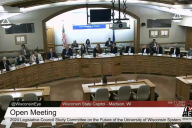You have /5 articles left.
Sign up for a free account or log in.
As the number of loan providers suspending or restricting their participation in the federal guaranteed student loan program has grown in recent months, citing uncertainty in the credit markets, questions have arisen about whether the perceived lack of availability of loan funds would drive more colleges into the government's competing direct loan program. So far, despite a relative handful of announcements from major institutions like Indiana, Michigan State, Northeastern and Pennsylvania State Universities, there have been few signs of a major shift.
But a new survey suggests that the flow of institutions bolting the guaranteed loan program could be significant. Student Lending Analytics, which provides data to financial aid officials to help them select lenders, among other purposes, reports that 5.8 percent of colleges now participating in the Family Federal Education Loan Program have already decided to switch to the federal direct loan program and another 19.3 percent are contemplating such a switch.
The numbers are particularly high for community colleges, with 7.2 percent of public two-year institutions already planning to switch and 28.9 percent considering making that move. That isn't surprising, given that major lenders such as Citibank and Chase Education Finance have announced in recent days that while they will continue to make federal student loans, they will be more selective, declining to make loans to students at institutions with many financially high risk students. Two-year institutions, which have many working students who are financially independent of their parents, and for-profit colleges are likeliest to fall into that category. (The survey found that for-profit college officials also said they were likely to jump to direct lending, but that the sample size was small.)
The survey, which was conducted April 24-25 and based on responses from officials at 428 colleges out of 2,500 asked, found that 39.5 percent of those who were considering switching to direct lending cited the frequency with which lenders were stopping making loans entirely or changing the terms under which they make loans. Another 33.7 percent cited concerns regarding the financial stability of lenders, and 7 percent cited new regulations that govern the lists of preferred lenders to which colleges direct their students -- changes that came about because of last year's student loan controversy.
Numbers on how many colleges are switching, or might switch, into direct lending will be closely watched for multiple reasons. One is to gauge the continued health and viability of the federal guaranteed loan program, although most experts do not anticipate that the program is in any grave danger, especially if, as expected, Congress and the Bush administration pursue a variety of means in the coming weeks and months to shore up the availability of capital to help lenders make loans.
(In related developments, several higher education associations, which have largely remained on the sidelines until now, on Tuesday called on Congress to quickly pass legislation to ward off a potential crisis in the loan industry. And the Senate released its version of that legislation and planned to "hotline," or expedite, a vote on the measure. The Senate's version closely resembled the House's; lawmakers in the Senate appear to have dropped an earlier plan to use the legislation to increase the maximum Pell Grant for the lowest-income grant recipients by up to $750.) Update: As expected, the Senate passed the student loan legislation on an expedited basis Wednesday.
The other reason why the trends involving direct lending matters is because of questions about how much capacity the direct loan program has to absorb new participants. Education Secretary Margaret Spellings (echoed by its chief financial officer, Lawrence Warder) has repeatedly said that the direct loan program can double its capacity immediately and conceivably increase it beyond that over time. The program once served more than a third of American colleges, but now provides about 20 percent of federal loans.
Rough estimates are that a 15 percent decrease in loan volume in the guaranteed loan program would result in a 60 percent increase in loan volume in the direct loan program. So if all of the roughly 25 percent of colleges that told Student Lending Analytics they were contemplating a switch followed through and switched loan programs, that would presumably double the current volume in direct lending.
The results of the survey may be viewed differently depending on who is looking at them, but in general, they do not suggest dramatic flight from the guaranteed loan program. But one other piece of data in the survey may bode badly for advocates of the lender-based program. Of the FFEL participants who said they were not contemplating a switch to direct lending, more than 40 percent cited as their main reason for staying in the guaranteed loan program the favorable "borrower benefits" that lenders can offer (in terms of discounted fees, etc.) over direct lending.
But as lenders reconsider their involvement in the program, many of them have announced plans to abandon or curtail borrower benefits, so it's possible that that advantage, and the perception of it, may erode over time.









